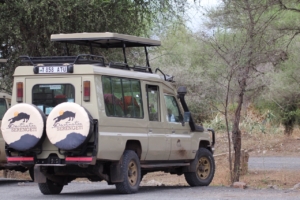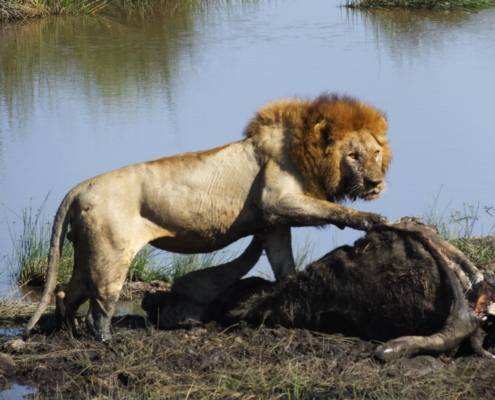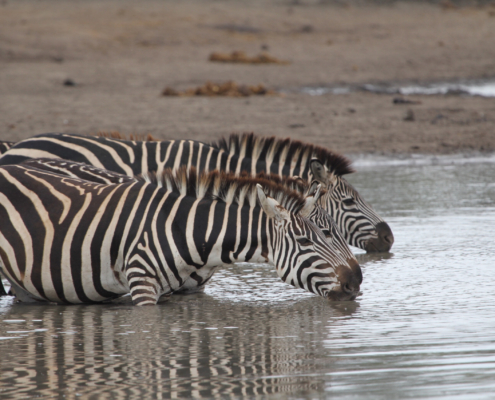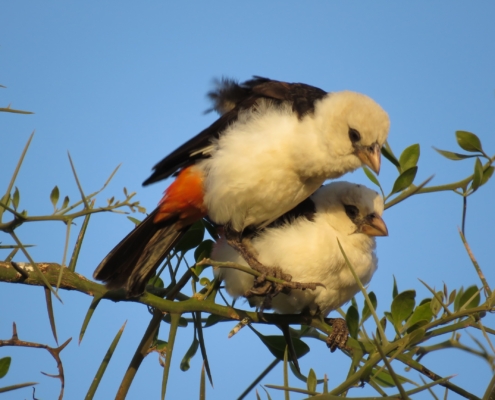A full eight days on safari is one of the perfect trips you can take. Many people come to Tanzania to visit the Serengeti National Park and see the marvel that is the Great Migration as millions of wildebeest traverse the plains and rivers, following the rains. If that describes you, this itinerary, which varies depending on the season and where the most wildebeest will be found, is almost certainly the one for you! This safari is eight full days, where you arrive in the afternoon or evening beforehand. (You may discover that many ‘eight-day’ itineraries are actually seven full days plus your evening arrival…)
If you’ve dreamed of wide-open plains where wildebeest and zebras roam, where leopards and lions lie in wait for unwary gazelle, where nature is both raw and rich, then this is the trip for you. The light ranges from golden to dazzling; animals live out the circle of nature, and photographers drool over the sights. Join Destination Serengeti for the ultimate safari experience!
We have put together a few options for your eight to nine day safari to help you discover what appeals to you, but we are also more than happy to custom design a safari to fit exactly what you want to see. So read on to start dreaming, but don’t hesitate to reach out to finalize where you will go and what you will see.
Because the wildebeest travel great distances over the year, this itinerary varies by season:
Following the Great Migration January – March
This season is when you have a chance at seeing the wildebeest calving in the Ndutu plains. During a three-week period (which varies year to year depending on the rains), hundreds of thousands of wildebeest drop calves on these wide-open plains. If this is when you travel, Destination Serengeti will have arranged accommodation in the Ndutu plains area, or near Lake Masek in a carefully selected camp or lodge.
Following the Great Migration April – May
This season is an amazing time to see predators in the Ndutu/Lake Masek area (in the Southern Serengeti). While it is technically low season and towards the end of Tanzania’s rainy season, there are some definite benefits to coming at this time of year. Predators are out and very active; you have a great chance of seeing their babies (lion cubs – so cute! cheetah young – even cuter!), there are fewer visitors so you get to enjoy your sightings in peace, and, for those who are birders, birding is amazing at this time of year! If this is when you travel, Destination Serengeti will have arranged accommodation in the Ndutu plains area, or near Lake Masek in a carefully selected camp or lodge.
Following the Great Migration June – July
This season is when the Great Migration moves through the central Serengeti; also known as the Seronera area. The central Serengeti is an amazing place at any time of year; with lots of viewing opportunities, watering holes galore, and generally lots of predators and game to spot. But boy does it come into its own in the June – July period. If this is when you are coming, you will most likely be based at one of the migratory tented camps, that move around following the herds. But don’t be fooled by the name ‘tented camps’; these provide luxury accommodations and the middle of the wild and remote Serengeti plains; you will be amazed! If you want to follow the Great Migration and come in June or July, you will end your fourth day of adventuring in a carefully selected camp or lodge in the Central Serengeti.
Following the Great Migration August – October
In this season, to find the Great Migration you want to be up in the Northern part of the Serengeti, in the Mara area. If you travel at this time, your fourth day will see you make your way up to the Northern Serengeti so you awaken on the morning of the fifth day ready for a Great Migration river crossing!
Following the Great Migration November – December
In the early part of November, you still have a chance to see those amazing Mara River crossings in the Northern Serengeti. The migratory herds of wildebeest slowly make their way towards the river, and then a pathfinder will gradually test the waters and decide whether it is safe to cross. Once he makes up his mind, thousands of wildebeest will follow in a great explosion of dust and thundering herds. With the right timing, you may get to see this once-in-a-lifetime explosive crossing, with crocodiles and hippos lurking in the shadows. Then as November goes on and December begins, if the rains are good, you start to see small and then increasing sizes of herds in the Central Serengeti as the pregnant females move down first, later followed by the males, towards the area where the females will give birth in the Ndutu Plains. If you come in this season, we will plan with you where in the Serengeti you will find the best Great Migration experience.





